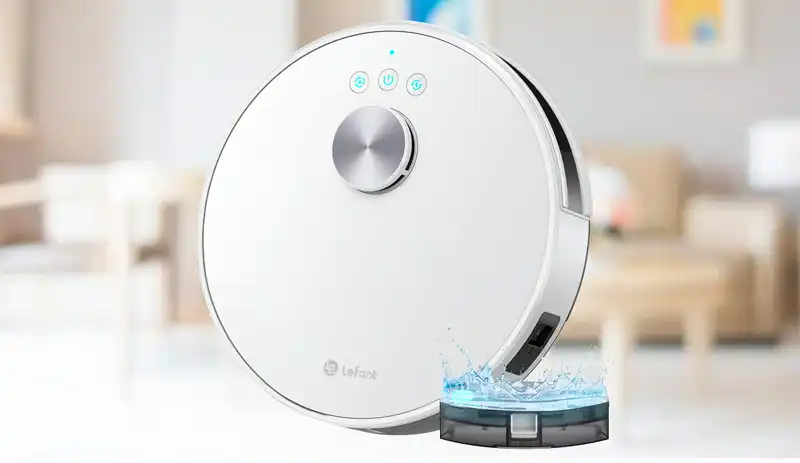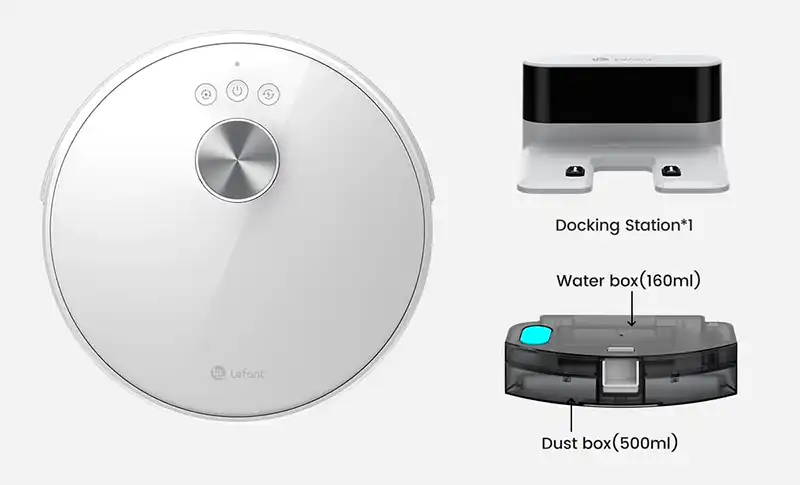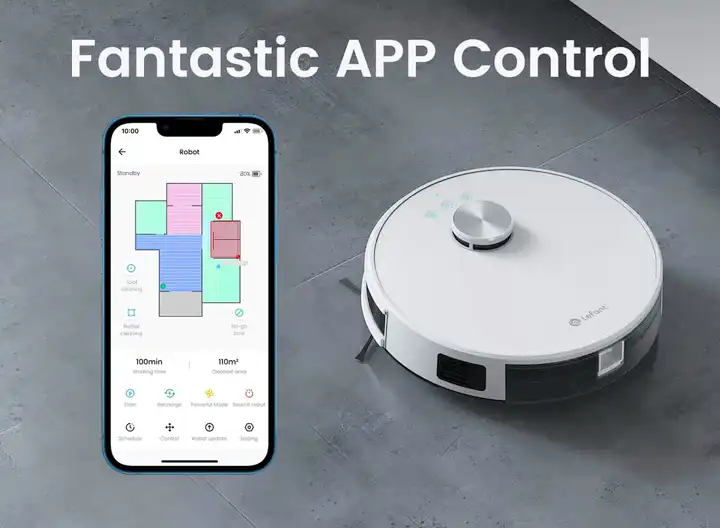You can also be interested in these:
The Lefant M1, an interesting robotic vacuum cleaner that efficiently vacuums and mops floors thanks to its LiDAR navigation sensor. The sensor is combined with the Freemove 3.0 system, which can detect objects from a distance and plot a route without colliding with them. The company is so confident in the effectiveness of the robot that it has replaced its bumper with protective rubber.
Under the hood, the robot features a motor with a suction capacity of 4000 Pa and a 4000 mAh battery that provides up to 150 minutes of autonomy. It also includes a dual side brush for increased cleaning coverage, as well as a wet mop system with both dirt and water tanks integrated into the same block to optimize space. Let’s see what this robot is capable of!

Exterior design
The Lefant M1 follows the standard circular design used by the majority of robotic vacuums on the market. However, it has a slightly more compact effective diameter of 320 mm and a height of 94 mm, allowing it to fit into small spaces. The outer casing is made entirely of plastic and is available in black and white versions, a rare option for a single model.
On the top, there is a cylindrical dome that houses the navigation system, featuring a silver roof and grills on the sides for the rotating camera. This model does not have a top lid, as the modular deposit system is fully removable.
Next to the LiDAR sensor, there is a panel with three buttons that perform the following functions:
- Return and charge button
- Start and pause cleaning button
- Fixed point mode button (traditional focused cleaning)
All buttons are backlit with a common LED that will turn blue to indicate normal operation and red when there is a problem. Opposite the buttons is another LED indicator for Wi-Fi connection.
Another distinctive feature of the Lefant M1 is that the typical front bumper with springs and sensors to detect impacts has been replaced with a double rubber edge that covers approximately half of the robot’s circumference. During use, we have found that at least the version with a white edge gets easily dirty from objects it brushes against. The black central area incorporates the anti-collision sensor.

The power switch for the device is located in the middle of the back half of the circumference, and the air outlet grill is on the opposite side. The entire central black space is part of the dirt/water/mop container, which has a button to unlock it and remove it from its anchor.
The charging base of the Lefant M1 is a basic type, consisting of a small block with a charging connection on one side and two contact points on the base. The station cannot be fixed to the ground, but this is not necessary as the robot never moves it, as we have verified.
Whisker brushes and charging base
At the base of the Lefant M1, we find the cleaning and movement system. The movement system consists of two large rubber toothed wheels powered by individual motors and a shock absorber spring to support at least 2 cm of uneven surfaces, like other robots on the market. At the front, there is a universal rotating wheel, also with a rubber surface to reduce noise.
On either side of the universal wheel, there are two large metal charging contacts, which ensure proper positioning for charging when entering the base. Four sensors have been installed around the front edge to detect changes in height and prevent falls.
Moving on to the cleaning system, the Lefant M1 consists of up to 4 different elements. The first are the two rotating side brushes on each end, providing a wider cleaning coverage. These are bristle brushes, which are more effective than rubber ones, in our opinion.
At the back, there is the main cleaning roller, with a mixed design of bristles and rubber edges to remove all types of dirt, including hair, lint, and dust. Thanks to its spring system, the roller can better adapt to irregular floors, removing dirt from the crevices of non-smooth surfaces.
The next element is the dirt container, which consists of a bottom container with a considerable capacity of 520 mL. It has an anti-return lid to prevent dirt from escaping, and the HEPA filter is installed on top, protected by a layer of foam and a particle filter. The protection is excellent, but the multiple layers may reduce airflow effectiveness if the filter becomes clogged. To remove dirt, simply press the button and it will open in half.
Above the dirt container is the 160 mL water tank, which uses an electric motor to pump water to the mop attachment placed on the base. The attachment uses a simple anchoring system with tabs at the ends and a small wheel to stabilize the robot in this part. The mop is attached to the surface with easily removable Velcro strips.
Features and capabilities of the Lefant M1 vacuum robot
The Lefant M1 is a complete robot capable of vacuuming dust and mopping floors with its wet mop. It uses a motor that can provide 4000 Pa of suction power in maximum mode, which has three modes (quiet, medium, and maximum). The maximum noise level is specified at 55 dB, slightly lower than some rivals that reach over 60 dB.
To achieve effective cleaning, it features LiDAR laser navigation, denoted by the cylindrical dome on top, which scans the floor to create a map and select the optimal route. Every time it goes out to clean, it scans the surface for changes, such as open or closed rooms, to adjust the route. The system is combined with the Freemove 3.0 technology, which includes additional sensors to detect objects in its path and adjust the route to avoid them. In fact, this robot rarely collides with objects, although it may brush against them, as it can avoid most of them except for very thin metal legs or elements that are in blind spots.
Regarding the water cleaning system, the dispenser consists of an electric motor integrated into the robot that pumps water to the base where several holes supply the air to the surface to soak it. It has 3 configurable flow levels from the software. To connect the robot to the app, it uses 2.4 GHz Wi-Fi.
The battery is made of iron phosphate and lithium and has a capacity of 4000 mAh. It can provide approximately 150 minutes of runtime in quiet mode, covering an area of about 200 m2, according to the manufacturer’s specifications. A full battery charge cycle takes about 5 to 6 hours, so it’s ideal to do it overnight to have it ready for work in the morning.
Management app and setup
Now it’s time to put this Lefant M1 to work and tell you about our experience using it, its app, and its performance in suction and mopping. We downloaded the Lefant application from Google Play for an Android device, using the QR code provided in the instructions or searching for it directly in the store.

We added the model in question, which must be turned on by pressing the switch on its side and waiting for the voice prompt to indicate that the robot is on. Next, we selected the 2.4 GHz Wi-Fi network under which we would connect the robot while holding down the power button until the Wi-Fi LED starts flashing. At this point, the app will prompt us to connect to the robot’s own Wi-Fi, and pairing will immediately take place.
Results and use experience
The navigation system of the Lefant M1 has been highly effective, avoiding collisions with furniture, chairs, and obstacles in its path. It is only unable to detect thin-legged objects with bases, leading to occasional collisions. Its slim design, with a thickness of 94mm, allows it to clean under furniture with ease.
The cleaning performance is excellent, thanks to the combination of bristles, a rubberized section, and two front brushes that cover a wide area. However, it may encounter some difficulty with long hairs getting tangled in the brushes, and it has performed well on medium-thick carpets, though it still struggles with small ones, as with other similar robots.
The mopping system of the Lefant M1 provides a standard performance, although it does not reach the effectiveness level of the rotary mops of the Dreame W10, which is considered a reference in this specific aspect. The water dispenser works quite well and manages to cover the entire area where the mop passes, but it obviously cannot get into the grooves of the rustic floor on which it was tested. The zigzag passes are adjusted so that the mop can cover the entire area without leaving gaps, considering that the width of the robot is greater than the mopped area, but it will not reach the corners or stick to the edges.
Final thoughts about the Lefant M1 vacuum robot review
The Lefant M1 has performed well in testing, particularly in its suction system with a mixed roller and dual front brush. It can reach edges, corners, and under furniture, has sufficient power, and is not particularly noisy. The battery life is approximately as expected, although it runs a few minutes shorter, it can last more than 135 minutes in silent suction and mopping mode.
The robot has a considerably large tank that optimizes the space by placing the water tank on top. It is easy to remove and clean. However, the three-layer filter could be a disadvantage if there is a lot of dirt, as the first layer can easily clog and decrease airflow. The mopping performance is standard since it lacks a rotating or oscillating feature compared to the Dreame W10.
The navigation system works well, leaving no dead zones, detecting objects, and following an optimal route on the second pass after scanning the map. It can save up to 3 maps, but some features like customizing rooms are missing.
